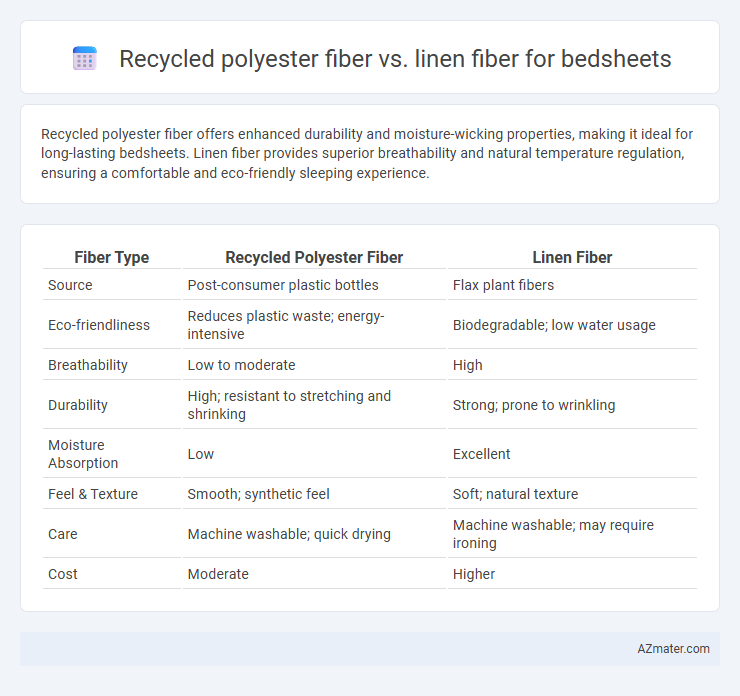Recycled polyester fiber offers enhanced durability and moisture-wicking properties, making it ideal for long-lasting bedsheets. Linen fiber provides superior breathability and natural temperature regulation, ensuring a comfortable and eco-friendly sleeping experience.
Table of Comparison
| Fiber Type | Recycled Polyester Fiber | Linen Fiber |
|---|---|---|
| Source | Post-consumer plastic bottles | Flax plant fibers |
| Eco-friendliness | Reduces plastic waste; energy-intensive | Biodegradable; low water usage |
| Breathability | Low to moderate | High |
| Durability | High; resistant to stretching and shrinking | Strong; prone to wrinkling |
| Moisture Absorption | Low | Excellent |
| Feel & Texture | Smooth; synthetic feel | Soft; natural texture |
| Care | Machine washable; quick drying | Machine washable; may require ironing |
| Cost | Moderate | Higher |
Overview: Recycled Polyester Fiber vs Linen Fiber
Recycled polyester fiber, made from post-consumer plastic waste, offers durability, moisture resistance, and affordability for bedsheets, whereas linen fiber, derived from flax plants, provides natural breathability, hypoallergenic properties, and a luxurious texture. Recycled polyester excels in wrinkle resistance and easy maintenance, while linen is prized for its temperature regulation and eco-friendly biodegradability. Both fibers present sustainable options but differ significantly in tactile feel, environmental impact, and performance characteristics for bedding applications.
Sustainability Comparison: Recycled Polyester and Linen
Recycled polyester fiber reduces environmental impact by repurposing plastic waste, cutting down on energy use and carbon emissions compared to virgin polyester, but it remains a synthetic material with limited biodegradability. Linen fiber, derived from flax plants, offers superior sustainability through natural biodegradability, minimal pesticide requirements, and lower water consumption during cultivation. Bedsheets made from linen promote eco-friendly living with renewable plant-based origins, while recycled polyester contributes to circular economy goals by diverting plastic waste from landfills and oceans.
Production Process and Environmental Impact
Recycled polyester fiber for bedsheets is produced by melting and re-spinning plastic waste, significantly reducing landfill and ocean pollution while consuming less energy compared to virgin polyester production. Linen fiber, derived from flax plants, involves a labor-intensive process including retting, scutching, and spinning, with minimal chemical use, making it biodegradable and naturally sustainable. Linen's cultivation improves soil health and requires less water and pesticides than cotton, whereas recycled polyester helps divert plastic waste but remains a synthetic material with potential microplastic shedding during washing.
Comfort and Breathability for Bedding
Recycled polyester fiber offers durability and moisture-wicking properties but tends to retain heat, making it less breathable compared to natural fibers. Linen fiber excels in breathability and moisture absorption, providing a cooler and more comfortable sleeping experience due to its natural fiber structure. For bedding, linen's superior airflow and temperature regulation contribute to enhanced comfort, especially in warmer climates or for hot sleepers.
Durability: Longevity of Recycled Polyester vs Linen
Recycled polyester fiber offers superior durability and resistance to wear, making bedsheets more long-lasting and less prone to tearing compared to linen fiber. Linen, derived from flax plants, provides natural strength but tends to weaken and develop frays over time with frequent washing. Choosing recycled polyester ensures extended longevity and maintains the structural integrity of bedsheets through repeated use and laundering.
Maintenance: Washing and Care Requirements
Recycled polyester fiber bedsheets offer easy maintenance with machine-washable durability, quick drying times, and resistance to wrinkles and shrinking, making them ideal for low-effort care. Linen fiber bedsheets require gentler washing at lower temperatures and minimal agitation to preserve their natural texture and avoid excessive wear, although they become softer with each wash. Both fibers benefit from air drying or tumble drying on low heat to maintain fabric integrity and extend bedsheet lifespan.
Cost Analysis: Affordability of Both Fibers
Recycled polyester fiber typically offers a more affordable option for bedsheets due to lower raw material and production costs compared to linen fiber, which involves labor-intensive harvesting and processing of flax plants. Linen bedsheets tend to be pricier, reflecting higher durability, natural moisture-wicking properties, and eco-friendly cultivation practices. Cost analysis shows recycled polyester's competitive pricing appeals to budget-conscious consumers, while linen's premium pricing aligns with sustainable and luxury market segments.
Allergens and Skin Sensitivity
Recycled polyester fiber is hypoallergenic and resists dust mites and mold, making it suitable for individuals with allergies or sensitive skin. Linen fiber, made from flax, is naturally breathable and moisture-wicking, reducing the risk of irritation and promoting skin health. Both fibers offer distinct benefits for sensitive skin, with recycled polyester excelling in allergen resistance and linen providing natural comfort and breathability.
Aesthetic Differences: Texture, Color, and Style
Recycled polyester fiber offers a smooth and consistent texture with vibrant, long-lasting colors ideal for modern and sleek bedsheet designs, while linen fiber provides a naturally textured, breathable surface with subtle color variations creating a rustic and elegant aesthetic. Linen's unique weave enhances tactile interest and gains character over time through natural softening, contrasting the uniformity and durability of recycled polyester. Style preferences for bedsheets are often influenced by linen's organic, artisanal look versus recycled polyester's contemporary, polished appearance.
Final Verdict: Choosing the Best Fiber for Bedsheets
Recycled polyester fiber offers durability, moisture-wicking properties, and affordability, making it a practical choice for bedsheets, especially for those seeking eco-friendly options with low maintenance. Linen fiber excels in breathability, natural hypoallergenic qualities, and thermal regulation, providing unmatched comfort and a luxurious feel ideal for hot climates. The final verdict depends on prioritizing sustainability and easy care with recycled polyester or seeking premium comfort and natural texture with linen.

Infographic: Recycled polyester fiber vs Linen fiber for Bedsheet
 azmater.com
azmater.com